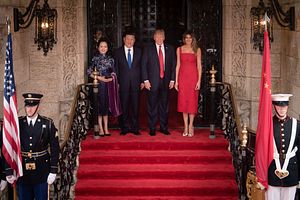Nothing could have less predictive value in gauging U.S. foreign policy direction under the Trump administration than its new national security strategy document.
The document released on Monday does offer something of a vision but no answers for observers seeking more clarity on how U.S. President Donald Trump’s populist-at-home, populist-abroad message of “America first” might translate into policy.
Consider that in his speech after the document’s release, when Trump was expected to reinforce the strategy’s overarching themes, he barely touched on it. His own National Security Council spokesperson even confirmed that while Trump might have had the document, he hadn’t “read every line and every word”. One wonders if he opened the document at all.
Given all this, Trump’s first national security strategy will remain little more than an exercise in giving the “America first” doctrine a little more shape in a purely theoretical sense. Reading it at face value, the document helps crystallise a familiar vision for U.S. foreign policy in Asia and the world: one privileging a role for the “contest for power”, if not leadership, and a winner-takes-all, zero-sum vision on economic policy and trade.
At its core, the strategy identifies three primary sets of adversaries for the United States. In terms of longer term strategic threats, there are the major “revisionist powers” China and Russia, which are explicitly singled out as challengers – despite Trump’s generally good personal relationships with Chinese President Xi Jinping and Russian President Vladimir Putin.
Below these two grand competitors, there are two other categories: the two rogue states of North Korea and Iran, and then terrorist groups and non-state actors. The document confirms that the U.S. remains ready to use “overwhelming” force against North Korea, thereby closing out 2017 with the spectre of a disastrous preventive war haunting the Korean peninsula.
But we shouldn’t discount the strategy entirely. Despite little interest at the level of the president, the document will be read by America’s foreign and national security policy bureaucracies.
For instance, one section drawing attention to the “Indo-Pacific” – the new, voguish appellation for the region roughly spanning the Arabian Sea to the Western Pacific – gives some insight into how the administration might operationalise a forward-leaning policy in Asia to succeed the Obama administration’s “pivot” or “rebalance” to Asia.
The document highlights a particular interest in Asia’s assertive and ambitious democracies, particularly India, Japan, Australia, and New Zealand. The U.S. has formed a new “quadrilateral” arrangement with the first three, restoring an old idea originally promoted by Japanese Prime Minister Shinzo Abe a decade ago. The U.S. administration professes an interest in furthering quadrilateral cooperation next year amid concerns about China’s rise.
If the strategy has any predictive salience for U.S. policy in Asia, it may be in relation to ties with China. Almost one year ago, Trump, as president-elect, signalled that he would immediately pursue an incredibly abrasive approach to China. He became the first U.S. president to speak to a Taiwanese president on the phone since the United States granted diplomatic recognition to China.
While in 2017 the China hawks at the White House – notably, Peter Navarro, Trump’s trade adviser, and Steve Bannon, the president’s former chief strategist – didn’t get their way, the year ahead promises to be a difficult one for the U.S. and China.
While the year in the bilateral relationship was dominated by trade and by U.S. attempts to win China’s acquiescence and cooperation on its “maximum pressure” campaign against North Korea, the year ahead might expand that agenda to broader strategic concerns – everything from the fate of the South China Sea to China’s military modernization and search for influence in the region.
If there’s anything to be taken away at all from this national security strategy document then, it’s that the Trump administration is ready to go all-in on a more adversarial relationship with China.
This article first appeared at the South China Morning Post. It is republished here with kind permission.

































